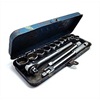Maintenance/Repairs
Getting your 4WD or tow vehicle, caravan or motorhome in top mechanical order is mandatory. If there is anything mechanically wrong then get it fixed before you leave. It is very expensive and can be time consuming to effect roadside repairs out in the middle of nowhere.
Items on a caravan or trailer to be checked include brakes, bearings,
suspension and tyres. All those items often get ignored and need attention whether they have been used regularly or not and tyres can simply perish by doing nothing. Consult your local caravan servicer/repairer if you don’t feel confident about handling the job yourself. If you have a van that’s been on the road for a few years, then have a good look at the chassis for any signs of damage or cracking, especially around
suspension and body mountings. Any problems should certainly be dealt with sooner rather than later.
Lights, electrics and gas systems should also be checked. Running lights in particular can be a problem if moisture has been able to get inside the lens cover. If your RV hasn’t been used for a while, then it’s prudent to check all the appliances to make sure they function. Don’t forget to inspect the power lead if it’s a few years old – for a nominal fee it can be “tested and tagged” by a licensed electrician.
Spares
It’s something of a dilemma in deciding what spares to take along but there are some basic things which should be on board.
- Fan belt
- Any other belts that the engine might have
- Radiator hoses
- Spark plugs
- Engine oil
- Coolant
- Spare wheel and tyre to suit caravan – some owners get matching tow vehicle and trailer wheels – means two spares for each vehicle.
- Insulating tape
- Electrical wire
- Spare light globe selection
- 12V fuses
 | Knowing what to take on a trip must firstly begin with specific requirements to keep your vehicle running and how to conduct roadside service if the vehicle breaks down. If you are driving a 4WD vehicle then this means you need additional gear such as recovery equipment, and since mechanical breakdown in a remote area could mean certain death for the vehicle occupants, you must be able to conduct basic bush maintence and have the tools and spare parts to get the vehicle moving again. See Spare Parts and Tools. |